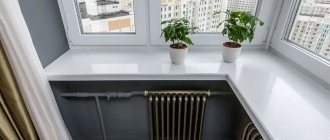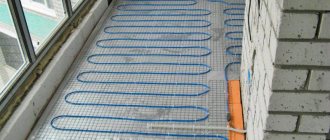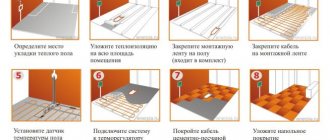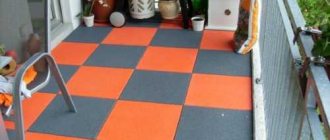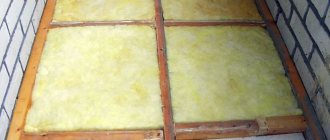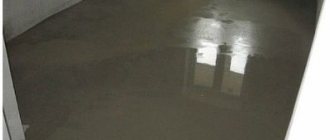There is never too much space in an apartment. Balconies and loggias, in their original design, are cold non-residential premises without heating. As a rule, they are used for arranging niches or built-in cabinets, equipped for drying clothes, or organizing a place to relax in the warm season. However, recently the tendency to connect non-residential unheated area of balconies to the common living area to create additional living rooms and offices has become increasingly used. To create a comfortable temperature, first of all in winter, you will have to organize heating on the balcony. This is not an easy procedure, but if you do it step by step, then all the issues can be resolved and you can add usable space to your apartment.
Battery on the balcony in an apartment with individual heating
Improved bimetallic, designer cast iron, cast aluminum
In terms of performance characteristics, namely, a long service life, cast iron battery models have. Their main drawback is that they heat up slowly. But at the same time, they cool slowly, prolonging the warmth in the room.
Steel batteries have a slightly shorter service life - 10-15 years. Steel radiators include tubular and panel radiators. The latter are in greatest demand. Steel ones will be more expensive, but the variety in shape and color allows them to be used for arranging designer balconies and loggias.
Aluminum batteries have an average service life of about 20 years. Light weight, compact dimensions (which is very important for installation on balconies) and variability of models have made them “favorites” among those who want to place the battery on the balcony. In addition, they also heat up quickly and have excellent heat transfer, which is also a positive indicator.
A good option for city apartments would be bimetallic options that are resistant to water hammer, inexpensive and have good heat transfer.
Choosing insulation for internal surfaces
After glazing on the balcony, the internal surfaces are insulated: ceiling, side walls, parapet, floor. Only the back wall, which borders the room, is not subject to thermal insulation.
The rear wall is not specifically insulated for heat exchange between the balcony and the interior living space.
The main criteria in choosing insulation are the dimensions and thermal insulation characteristics of the material. For balcony insulation, polystyrene foam, extruded polystyrene foam and isolon are mainly used.
Expanded polystyrene foam
It has been used for insulation of construction sites for more than half a century. Containing 98% air, which is located in closed polystyrene cells, the foam has a low mass, so it does not load the insulated structure.
Technical characteristics of polystyrene foam:
- density: 25 kg/m³;
- water absorption in 24 hours: no more than 2%;
- thermal conductivity: 0.038 W/m²°C;
- operating temperature range: -60 ÷ +80 °C.
To make a warm balcony, a 50 mm thick sheet of foam plastic is used for the walls and ceiling, the heat transfer resistance of which is 1 m² °C/W. The sheets are secured with special glue or plastic mushrooms, and the joints are treated with polyurethane foam.
Foam plastic is the most affordable insulation for balconies
Read about the technology of insulating a balcony with polystyrene foam in the detailed instructions.
Extruded polystyrene foam
Like polystyrene foam, extruded polystyrene foam is made from polystyrene, so the materials are similar in appearance. The difference lies in the production technology. Thanks to the extrusion method, a polymer product with a dense structure is obtained, which increases its strength and thermal insulation properties.
Technical characteristics of extruded polystyrene foam:
- density: 35-45 kg/m³;
- water absorption in 24 hours: no more than 0.2%;
- thermal conductivity: 0.030 W/m²°C;
- operating temperature range: -60 ÷ +80 °C.
When installing extruded polystyrene foam, the insulating layer is thinner compared to using polystyrene foam. It is possible to install sheets 30 mm thick, which have almost the same thermal resistance coefficient as 50 mm polystyrene foam.
>
Extruded polystyrene foam allows you to create a uniform insulating contour on the balcony
The “extruder” is dense and easily bears the weight of a person. used for walls, ceilings, and floor insulation without additional sheathing.
How to insulate a loggia with Penopex (modern insulation based on extruded polystyrene foam), watch the video tutorial:
Foamed polyethylene
Elastic polyethylene foam is well known to tourists; rugs for relaxation and overnight stays are made from this material. Even with a small thickness of the coating, foamed polyethylene is an excellent heat insulator. Builders use the material when arranging warm balconies and loggias.
Technical characteristics of foamed polyethylene:
- density: 33 kg/m³;
- water absorption in 24 hours: no more than 3%;
- thermal conductivity: 0.033 W/m²°C;
- operating temperature range: -80 ÷ +95 °C.
The main advantage of polyethylene foam over other insulation materials is its size. Rolled material with a thickness of only 10 mm is capable of providing a heat transfer resistance of 0.97 m²·°C/W, this is enough for high-quality surface insulation.
Foamed polyethylene on the balcony saves internal space
Installation and self-installation of a heating battery on the balcony
Studying what has already been written on this topic on the Internet, I found many articles that give some instructions for moving the battery to the balcony with your own hands. Such information content, on the one hand, benefits readers - after all, you don’t need to go anywhere and find out something, just take it and do it, as they say. But on the other hand, for some reason many do not take into account that this set of works is quite complex to perform and carries a lot of danger. One wrong step and you risk flooding the residents on the floor below.
Such work should be carried out exclusively by masters and specialists in this field. Even if you are not a “noob” at repairs, this does not mean that you can cope with connecting elements to a central heating system. The question is different - professionals absolutely refuse to carry out this kind of work if the customer does not have permits in hand. In fact, this is what encourages “home craftsmen” to do everything with their own hands. My recommendation is to still get permission, even before starting the repair, so that you don’t “stand idle” later, or, if you were not given permission, find an excellent alternative to moving the battery to the balcony - installing a heater.
Alternative solutions for heating balconies - heaters
When it comes to heaters on balconies, apartment owners are skeptical about this - they consume a lot of electricity, take a long time to heat up, and are ineffective.
This was the case 5 years ago, when basically you could only buy a fan heater, popularly called a “wind blower”. They really consumed a lot of electricity, and after they were turned off, the room cooled down again. With the advent of infrared heaters, the situation with heating on the balcony has changed significantly for the better. They quickly heat the room, consume little energy, are safe to use, they can be left on overnight, and when the required temperature is reached, the system automatically turns off the device. If, in addition to such a heater, you install a warm floor, you can spend time on your balcony in complete comfort. Regardless of the temperature outside the window.
I talk more about the types of heaters in this article.
If you still have questions or need help regarding heating your balcony, you can always contact me by phone, email, or through social networks. Best regards, Vladimir Kozhushko!
Tel
” data-title=”Installing and removing the battery to a balcony or loggia” data-background=”none;” data-options=”small,square,line,horizontal,nocounter,sepcounter=1,theme=14″ data-services=”vkontakte,odnoklassniki,facebook,twitter,google,moimir”>
Convector heater
A convection heater (thermal panel) works on a principle similar to a fan. But you won’t hear any noise from it, no matter how hard you try.
The convector can be left on 24 hours a day
Operating principle of the convector
In general, a convector has all the advantages of a 21st century heater. Heats up quickly, turns off when needed, and is easy to install. And you can place it wherever your heart desires: on the floor, wall and even ceiling! Depending on which part of the balcony needs to be heated.
However, the convector also has disadvantages . Firstly, it dries out the air, which can give you a headache. Secondly, like all electric heaters, it uses a lot of electricity. To heat 1 m2 of balcony per month in Moscow it costs at least 324 rubles! This is if the balcony is well insulated. If not, the costs will increase many times over.
Heating on the balcony. How to remove the battery to the loggia?
In a small apartment building, there are no extra square meters. Lately it has become fashionable to use a balcony as a full-fledged room, for example as a study or just a place to relax. The practicality of such a solution is difficult to overestimate, but it is necessary to provide heating on the balcony, otherwise the whole idea will fail.
Pantry for storing food and supplies
To store canned products, a temperature of +5 to +15 °C is required. Fresh vegetables, such as potatoes, store well at temperatures around +5 °C.
If it is not too cold outside in winter, the storage room on the balcony can receive enough heat through the slightly open balcony door. In severe frosts, you will have to turn on the heating, and then wall convectors are suitable.
To store vegetables, you can buy a special thermal container equipped with automatically controlled heating and ventilation.
Heating devices are connected directly to the network or plugged into sockets.
How to heat a balcony in winter: popular options
Before installing heating on the balcony, it is necessary to finish it and insulate it. How to make it suitable for living all year round? You can use one of seven options.
Traditional steam heating
Installing an additional battery for a balcony or loggia is a great idea, because this method is simpler than others and has no equal in terms of efficiency. But there is a big disadvantage - this is the possibility of encountering legal problems. The fact is that removing the battery will probably be illegal. It is futile to hope that no one will notice anything.
When one of the residents of an apartment building has an individual battery on the balcony, residents of neighboring apartments may feel a decrease in heat transfer from their own radiators. The reason lies in the design features of central heating. However, this method should not be written off prematurely. Such issues are discussed with housing and communal services employees - with their help you can obtain the necessary permission.
Electric heating
The balcony heater can also operate using electricity. This is equipment such as a convector or oil heater. Easy to install, it is ideal because it can be turned on and off as needed. But there are also significant disadvantages. The first and main one is an increase in energy costs.
The second drawback is the unpleasant odor that appears due to low air humidity in such a small room as a loggia or balcony. It is enough to install an air humidifier in a heated balcony to prevent this from happening. The third disadvantage is the increased fire hazard. Installing an oil heater is justified where they do not spend too much time on the loggia.
Infrared heating
A rather innovative way to make a balcony or loggia warm is with ceiling and wall infrared panels.
The effect of infrared heat on the surrounding space is similar in its properties to sunlight. Modern infrared heaters for the balcony will not only make it suitable for permanent use in winter, but will also have a very positive effect on the walls and floor.
Infrared light will prevent condensation from accumulating on the walls and prevent the possibility of mold or mildew.
This is one of the cleanest methods of heating a loggia from an environmental point of view. In addition, it is very economical.
But the installation itself cannot be called cheap. In addition, if the loggia is large, then the infrared heater may not be able to adequately heat the room.
Warm floor
If you want to include floor heating in your loggia heating, then this option is best suited. There is just one important point: the heated floor is laid before pouring the concrete screed. Read more about this method here.
If the balcony is small, then one heated floor is enough to heat the entire room. The method is good for its effectiveness, but difficult to install. There is also some fire hazard (for the electric type).
Warm baseboard
This is a modern balcony heating that came to us recently from European countries. It is installed instead of a regular baseboard, but has a heat exchange heating module inside. Usually these are two copper tubes with brass lamellas. This type of balcony heating includes a distribution manifold, from which the coolant is supplied to the heater. Like the floor, a warm baseboard can be powered by electricity or water.
Solar panels
Solar panels for apartment heating have appeared quite recently. Heating on the loggia using solar energy is convenient for owners of private houses. It is problematic to implement this in a city high-rise building, but it is possible. But still, a solar battery on an ordinary balcony is a rare occurrence. In the Russian climate, the option of such heating is, of course, controversial.
In addition, this is one of the most expensive ways to heat a balcony - it all depends on the cost of solar panels. The solar battery itself on your balcony will not create a warm atmosphere: it only collects solar heat, which is converted into electricity through a special device. The electricity can then be used to power a heater.
The principle of operation of a solar battery
Glazing of balconies and loggias
To ensure that a sufficient amount of natural light penetrates into the room, most of the balcony space is occupied by windows. Standard glazing does not serve as a serious barrier to cold air. PVC profiles with multi-chamber double-glazed windows will correct the situation.
Why PVC? Wooden window structures, made taking into account heat saving criteria, are an order of magnitude more expensive and create an increased load on the base of the balcony. Aluminum profiles have the lowest price among all glazing options, but have low thermal resistance, so they are not used to create warm objects
Metal-plastic profile design
>
PVC profiles have a hollow structure, inside of which there are partitions that form separate chambers. The thermal insulation characteristics of the profile depend on the number of chambers.
On the market you can find 3-chamber, 4-chamber and 5-chamber frame profiles. The latter are considered the best option for arranging a warm balcony or loggia with a heat transfer resistance coefficient of 0.8 m² °C/W. For comparison, in a 3-chamber profile the same parameter is 0.6 m²·°C/W.
An important point when choosing a PVC profile is the presence of reinforcement (a metal profile made of durable galvanized steel is inserted into one of the internal chambers), which increases the rigidity of the structure. Some manufacturers save on metal when producing frames and windows, making the product cheaper. For load-bearing structures, which include balcony glazing, this option is unacceptable.
For warm glazing, a 5-chamber profile with a thickness of 70 mm is used
Thickness and coating of double-glazed windows
Like metal-plastic profiles, double-glazed windows are classified by the number of chambers: 1-chamber, 2-chamber, 3-chamber, etc. A double-glazed window with one chamber consists of two glasses of 4 mm each, between which there is an air partition 10-16 mm thick. The heat transfer resistance of such a product is 0.32 m²·°C/W, which is not enough to organize warm glazing for a balcony.
To obtain the necessary thermal insulation properties of a window block, at least 2-chamber double-glazed windows with a total thickness of 32-42 mm are used. In addition, the glass must have a special coating designed to reflect thermal radiation generated by heating devices. Such energy-saving glass allows you to increase the overall thermal resistance coefficient of a 2-chamber double-glazed window to 0.9 m² °C/W.
>
The principle of operation of energy-saving double-glazed windows
Window unit configurations
The frame design and glazing configuration affect reliability, durability, and ease of use. If the length of the balcony or loggia exceeds 3 m, then making a solid frame is impractical for the following reasons:
- A large frame has less rigidity and can therefore deform under external loads.
- A large product is difficult to deliver to the site, lift to the floor and install.
- The coefficient of linear expansion of PVC is 1.5 mm per 1 m. For example, for a 6-meter frame, the difference in the dimensions of the structure in winter and summer will be about 10 mm. This will lead to the appearance of gaps between the beads and problems with opening the sashes.
For large balcony objects, the frame is divided into several separate sections of 2-3 m each. If the apartment is located below the 9th floor, then it is permissible to use a solid 3-meter product, which is lifted using ropes. In the case of a higher location of the object, delivery is possible only by stairs or using an elevator, which forces sections to be made with smaller dimensions.
The number of warm windows on the balcony is determined by the length of the room and its internal arrangement. For a 6-meter loggia, the glazing is divided into 8 equal parts with 2-4 tilt-and-turn sashes. There is no point in making all the doors open:
- firstly, the tightness of the entire block is reduced;
- secondly, open windows increase the load on the frame;
- thirdly, each swing-out flap adds up to 10% to the cost of the product.
Opening windows must be placed in such a way as to be able to service the outer surface of the blind sashes
Rules for fastening the frame
When installing warm glazing on a loggia or balcony, adhere to the following rules:
- Frames are attached to the side walls and parapet exclusively with anchors with a pitch of 50-60 mm and a recess of 40 mm (concrete) or 60 mm (brick). For ceilings, reinforced mounting plates can be used.
- The foam seam on the sides of the frame should be 25-40 mm to create a warm junction between the structure and the wall. On top, the thickness of the seam should be at least 30 mm, while the maximum value can reach 140 mm depending on the unevenness of the top plate. The place where the frame is attached to the parapet must also be foamed. If the frame is mounted on a pre-built masonry of foam blocks, the thickness of the seam is 15 mm, if on a standard concrete or brick parapet - 30 mm.
- It is advisable not to use extensions and expansion profiles around the perimeter of the window unit. Such elements usually come without reinforcement, therefore reducing the rigidity of the structure.
- Support blocks are installed under each vertical profile (impost), mounting wedges are suitable. If the length of an individual section exceeds 900 mm, then the lining is additionally placed in its middle part.
- The internal plane of the frame must be on the same axis with the internal plane of the parapet. In this case, it is much easier to provide the necessary insulation of the junction unit.
Warm glazing of the balcony is carried out by a team of installers of 2-3 people
Battery on the balcony: step-by-step instructions for transferring
Of all the options for heating a balcony, the most classic is moving the battery to the loggia. If you have the appropriate permission, you can start working. You can't do without some construction and repair skills. It is assumed that the balcony in the apartment is glazed, finished and insulated. So, let's figure out how to install heating on the balcony.
The work needs to be done in the summer, when there is no water in the pipes. Next, we offer you brief instructions on how to remove the battery from the main living space. An option is being considered in which a new radiator is mounted on the balcony, and pipes from the battery from the room are connected to it.
1. First, preparatory work is carried out. Using a level, you need to mark the position of the radiator so that it is perfectly horizontal and the sections are vertical. In this case, the radiator should be placed at a distance of at least 12 cm from the floor, 10 cm from the window sill and at least 2-4 cm from the wall.
Important! The battery on any loggia is hung exclusively on a load-bearing wall.
2. 3 brackets are used to mount the battery: one at the bottom and two at the top. If there are more than 12 sections, then a third bracket will be required on top.
3. Pipes (plastic or copper) are prepared and threads are drilled on them. There should be a minimum of bends in the pipes.
4. In order to properly heat the balcony and prevent the temperature of the neighbors’ radiators from dropping, you will need the help of a mechanic who will carry out the necessary calculations taking into account the direction of coolant flow in your type of radiator.
5. The through circulation of water through the old radiator should be closed in the new one. To do this, the pipes are attached to special holes in the existing battery.
How to install heating if they are not there? In this case, branches are made from old pipes. Holes are drilled into them, commensurate with the outer diameter of the pipes going to the balcony. Fittings are welded into the holes.
6. From the room side, the pipes are attached to the radiator using flax sealant and thermal paste. Soldering flux is applied to the joints and they are processed with a torch. If for fittings, then with a solder or a fastening nut.
7. On the balcony side, all plugs and nuts must be installed on the radiator, as well as a valve for bleeding air. Complete sealing is ensured by flax and sealant. All soldering and insulating work must be carried out with the highest quality.
Tip: install control taps at the water inlet to help control the radiator temperature. You will also need to install a jumper and vertical pipes to drain water.
Temperature sensor installation
To ensure the necessary microclimate in the room, thermostats equipped with a temperature sensor are used. They interact effectively with cable systems and IR film.
The functions of the thermostat include maintaining the set temperature, adjusting it, and optimizing energy consumption. Depending on the modification, the functions of the device may vary.
The principle of connecting the thermostat is the same for any system. We will consider the features of installing a temperature sensor for heating mats.
One thermostat is able to regulate the temperature of several heating mats at the same time. Cable systems are connected in parallel, the maximum current should not exceed 16 A, which corresponds to 3600 W at 230 V
If the total power of the mats is greater, then installation of the thermostat requires additional equipment in the form of an input circuit breaker, an RCD, a power relay, a directional circuit breaker, and a special thermostat.
To install the regulator, you must perform the work in the following order:
- create a special hole in the wall for mounting the box;
- make a recess in the wall to install the power wire and create a hole for laying the connecting channel;
- perform installation and configuration according to the instructions;
- place the sensors in a corrugated plastic tube with a diameter of 16-20 mm.
The tube must be hermetically sealed at one end to protect the wires from solutions and water getting inside. From the opposite end, the tube is placed in the installed box.
It is recommended to place the regulator close to the wiring in order to save on supply wiring; it is advisable to install it on the wall in a living room in the most convenient place
The permissible bending radius of the wiring is at least 5 cm. The tube with sensors is attached to the floor. It must fit between the loops at a distance of at least 20 cm.
It is important to remember that during installation you cannot shorten the heating cable, replace supply wires, make adjustments to the design of the thermostat, or carry out repair and installation work with the supply voltage turned on.
How to heat a balcony in winter: brief conclusions
A balcony with an installed heater can become a full-fledged additional room. Heat can be transferred into it in different ways, both simple and exotic. When using solar panels for an apartment, all the electricity for heating the loggia will be free, but the installation will be too cumbersome.
Innovative warm plinth - the ideal solution for the smallest balconies. According to the experience of most, the simplest way to heat a small room is a conventional battery, but you must obtain permission from the BTI for its installation.
Heating on the loggia, how to organize it
Installing heating on a loggia is only the first step towards arranging a full-fledged residential area on it. Even the most advanced insulation can only retain heat, but does not produce it itself. This is why the loggia needs heating. There are several ways to organize heating on a loggia, photo below.
Warm floor
It is most effective to install heated floors on the loggia. There are three main types of such a system:
- Electric heated floor - contrary to popular belief, it does not consume much energy (180-200 W/sq. m.). Like any electrical appliance, such a warm floor requires wiring on the loggia. The cost of such heating is quite high, but quickly pays off due to the reliability and efficiency of the heated floor. Can be installed under all types of floor coverings, with the exception of floorboards.
- Water heated floor - ease of installation and low cost of materials make this type of heating in demand. A warm water floor on a loggia can be installed under any covering, but its main disadvantage is the need to connect to a heat source, which is usually a central heating battery - and this is rarely legal. In addition, leaks are possible, which are extremely difficult to eliminate.
- Infrared heated floors are a fairly expensive but effective way to heat a loggia. Film heating elements are installed under finishing. The principle of operation is to heat surfaces, not air. Among the disadvantages is fragility, so you should not install infrared heated floors in areas where heavy furniture will be placed. It is best to install such a warm floor under porcelain stoneware, laminate or linoleum.
The advantages of heated floors are:
- Uniform heating of the entire floor surface.
- Visual absence of battery.
- Saving usable space.
- Ensuring a comfortable room temperature.
Electric heating
This group of heating devices includes:
- Oil heaters.
- Electric fireplace.
- Air conditioner.
- Electric convectors.
A convector is the simplest and most common type of heater for a loggia, but it requires the installation of an outlet, that is, you must first provide electricity to the loggia.
For heating loggias up to 5 sq. m. you can install a 1 kW heater, which will ensure uniform and rapid heating of the room. Such heating does not dry out the air, but is expensive if used continuously.
Removing central heating to the loggia
Removing the battery is the most economical, but has its significant disadvantages:
- To move the battery to the loggia you will need permission from the BTI, which is quite difficult to obtain.
- There is a possibility of a pipe burst, which will have serious consequences. This can happen if the heating is temporarily turned off.
Important: The main reason for the ban on removing the battery to the loggia is a decrease in pressure in the heating system, as the number of consumers increases.
Greenhouse or vegetable garden
Most decorative tropical plants can be kept on a closed balcony in winter. To survive, a temperature of +16 to +20 °C is enough for them. If you need to grow not only cacti and tradescantia, but also vegetables, then the air temperature should be from +25 °C.
Wall-mounted convectors, which can be placed on the outer wall of the balcony under the windows, are suitable for heating the greenhouse. As a rule, convectors have power control and overheating protection. Convectors must be plugged into an outlet.
The heating element of the convector is covered with a casing that protects against accidental burns. Source
If there are a lot of plants on the balcony, they will interfere with air circulation. In the far corners the air will stagnate and a lot of moisture will form: an unnecessary greenhouse effect will be created; such a climate is harmful for many plants. In this case, fan heaters can help: they create a flow of warm air that equalizes humidity.
Heaters of this type are compact, safe, and equipped with power control. They have one significant drawback - they make noise during operation. To prevent noise from being annoying and disturbing, the fan heater is turned on for a while and then removed.
The air flow from the fan heater can be directed in different directions. Source
Transferring the battery to the loggia
Important: Removal should only be done during the warm season, when the heating is turned off. Work is carried out only after glazing the loggia and carrying out work on its insulation.
Step 1
The location where the battery will be installed is marked. It should be close to the load-bearing wall, but at some distance from the door.
If the loggia area is about 6 sq. m or less, then to heat it you need 3-4 battery sections.
- Grinder, hammer drill and file.
- Steel plates.
- Polyurethane foam and cement mortar (1 part cement to 3 parts sand).
Step 2
Several holes 50 mm deep are hollowed out in the load-bearing wall with a hammer drill, cleaned and a steel plate is inserted into them (thickness up to 2 mm, width 25-30 mm, length - 300-350 mm):
At the location where the battery is installed, a grinder makes small recesses for mounting the entire structure.
Opposite the insertion points of the battery on the main pipe, the wall is punched through with a perforator. The holes made must be expanded to a pipe diameter of +50 mm.
Step 3
- Battery, pipes and fittings.
- Sealant, die and vice.
- Welding machine and tape measure.
The main pipe is cut with a grinder and has an external thread, onto which fittings with an additional branch are installed.
Pipes with a 9 cm protrusion are led out through the wall. At their ends, threads are similarly made for attaching corner fittings.
The battery is installed in a prepared place, and pipes 25-30 cm long are removed from it (an angle fitting must also be screwed onto their ends). The junction of the pipe and the battery is welded, the seams must be processed as efficiently as possible.
After this work, vertical pipes are installed that supply and drain water from the battery - they are screwed into ready-made fittings.
The detailed process of installing the battery on the loggia can be seen in the video:
Instructions on how to install the battery on the balcony
Surely, when it comes to heating, a central heating battery pops up in everyone’s imagination, which heats most apartments in Russia. What to do if heating needs to be carried out on a balcony or loggia? Is it possible to take the batteries out onto the balcony? This solution cannot be called easy to implement.
This is not only about the technical side of the issue, but also about the need to obtain legal permission to implement this idea. For those who no longer want to bother with paperwork, we can recommend an alternative option. You can create a heated floor system on the balcony, install an air conditioner, or even simpler, simply use oil and infrared heaters. For the most part, it is permissible to use electrical appliances on the balcony, because it is impossible to use gas and coal to heat this type of room. Read how to install railings on a balcony and which type to choose.
In the event that the desire to install a heating battery on the balcony remains, the information provided in this article will be very useful.
Why can’t you take the battery out onto the balcony?
The unauthorized installation of an additional heating element on the balcony, first of all, has a number of negative consequences for other apartment owners who use the same riser, and secondly, it can lead to an emergency situation.
Specialists make special calculations regarding the number of heating facilities supplied, the required temperatures and operating water pressure. It turns out that connecting an additional element to the system reduces the overall performance, and if there are several heating batteries, then during the cold season it will become much cooler in the neighbors’ apartments. If the insulation of the balcony is carried out with a number of deviations from the rules and building codes, in winter the temperature in the room may drop significantly. As a result, the coolant in the radiator will freeze, which will subsequently lead to an accident and leave the entire house without heat. Read how to make a ceiling on a balcony on this page.
In order to install a battery on a balcony, you must obtain permission. You will need to call the appropriate authorities and inform them of your decision. Next, engineers will need to check the quality of the balcony insulation, and certified specialists will make a conclusion about the suitability of the room for the installation of heating equipment connected to the central riser. They must also conclude that the installation of this element will not lead to an accident.
Only after this the apartment owner receives permission and can begin preparatory work. In the event that the battery is removed to the balcony personally, without appropriate checks, the owner of the premises will have to pay a fine, and if an emergency occurs during operation, the owner of the apartment will have to pay out of his own pocket for the damage caused to the property of other residents. The photo shows a heating radiator on the balcony. If all procedures have been followed, then you can proceed to choosing a battery. One of the most popular types of batteries at the moment is considered to be an aluminum radiator. This device, which has a high level of reliability and relatively low weight, which makes the installation process much easier, can be an ideal option for heating a balcony. A biometric radiator is also considered a good option.
If it has been decided to make the balcony part of the apartment, you should think about how to design the heating device and make it part of the room.
The picture shows the battery on the loggia
You can install gratings; today they are made from various types of materials. Also, the batteries themselves can have a bizarre shape.
The picture shows an insulated balcony with a battery installed
They may vary in color and material from which they are made. But the main thing that batteries should do is “give” heat.
Cast iron radiator on the balcony in the photo
How to get to the balcony?
In order to install a heating radiator on the balcony, you need to buy a number of elements. These include shut-off valves, Mayevsky valve, control valves, plugs and foot nuts. All elements must be installed correctly. For the main line, you should choose polypropylene pipes, which have excellent technical characteristics. Read the instructions for installing a heated floor on a balcony here: https://balkonus-pro.ru/uteplenie/rukovodstvo-po-ustrojstvu-teplogo-pola-na-balkone.html.
How to install?
Installing a heating battery on a balcony requires care and attention, because the functionality of the heating element depends on a number of nuances that are invisible at first glance.
In order to install the heating element level, you should use a building level. Brackets are used as suspensions; they are attached to the top. The minimum number of brackets is 2; if there are more than 10 sections, then there may be more brackets.
One bracket is installed below; it is necessary to fix the position of the battery.
Solar battery
But they are only suitable for owners of apartments on the upper floors of buildings. Otherwise, the battery will not receive enough solar energy, which will significantly affect its functional qualities. Such a battery can not only heat the room, but also generate energy to illuminate the balcony.
Before installing this device on the balcony, it is necessary to take into account the fact that batteries do not work at low temperatures, therefore, all stored heat will be lost. To prevent this from happening, the room should be well glazed and insulated. Read what kind of wardrobe you can arrange on the balcony on this page.
Video
Watch the video for instructions on installing the battery on the balcony:
Comparative analysis of materials for an open balcony
When planning to make a balcony floor with your own hands, you need to take into account the advantages and disadvantages of various flooring materials, and not just their applicability for installation “outdoors”.
Tile
Most often, the floors of balconies and loggias are tiled. This is a strong, durable, wear-resistant material, little susceptible to fluctuations in temperature and humidity. However, there is one caveat - it should be a tile specifically for outdoor use.
To make it easier to navigate the variety of species presented, you should focus on traditional labeling.
For balconies/loggias the following parameters are especially significant:
- tile thickness - too thin may not withstand the load, too thick creates excess load on the supporting structures;
- frost resistance - the material should not crack even in extreme cold;
- application for floor coverings. Such models have increased wear resistance and abrasion resistance;
- surface roughness (friction coefficient, including for a wet surface). Smooth tiles with a glossy surface are not suitable for open balconies and loggias - the risk of slipping after snowfall or rain is too great.
It is also advisable to pay attention to the resistance of the tiles to chemicals and thermal effects, especially if it is customary to smoke or drink tea/coffee/wine/beer on the balcony. Taking into account the above, for a balcony/loggia/veranda/terrace of an open type, we can recommend tiles with the following parameters:
Taking into account the above, for a balcony/loggia/veranda/terrace of an open type, we can recommend tiles with the following parameters:
- side dimensions 20...35 cm;
- thickness 8…12 mm;
- rough non-slip surface, preferably with relief;
- increased frost resistance, resistance to chemical influences, ultraviolet radiation;
- neutral tones without large intrusive patterns.
The tiles must be installed on a prepared base - a screed (as flat and smooth as possible), a slab or flooring made of slab materials. The optimal type of installation is with frost-resistant glue.
The specific gravity of the tile covering is 11…25 kg/sq.m.
Subject to the above conditions, finishing the floor on the balcony with tiles will ensure safety and an attractive appearance without unnecessary costs.
Terrace board
This material, also called deck board or decking, is based on stabilized wood or imitates wood (PVC board).
The characteristics of the board vary greatly from different manufacturers, so it is necessary to clarify them directly upon purchase. As an example, data for one of the varieties is given.
The material was originally intended for outdoor use, including installation near water, so there is no need to worry about the flooring becoming damp, becoming slippery, or quickly losing its appearance.
Installation is carried out on logs, accordingly, the total weight of the flooring will be significantly less than when installing a tile floor with a preliminary screed device. Even taking into account the logs, the load per square meter of the balcony/loggia will be 22…35 kg.
Screeds and self-leveling floors
These materials allow you to level the floor on the balcony and at the same time give it the properties necessary for further installation of the floor covering.
Screeds are distinguished:
- cement-sand, with a specific gravity of 1600...2000 kg/m3.
- lightweight, with a filler of large and small granules (slag, expanded clay) - specific gravity 1000...1600 kg/m3;
- light “warm” with a high content of light granules (expanded clay, perlite, vermiculite, polystyrene foam, etc.) 450...1000 kg/m3.
The latter type is considered optimal for arranging balconies, since it creates minimal load on the supporting structures and at the same time has good heat-insulating properties.
Self-leveling mixtures are based on cement, gypsum and polymer materials (epoxy resin, polyurethane). The first two types are used for starting and finishing leveling, respectively, the last one is used as finishing. The specific gravity of the mixture depends on the composition and for cement mortars it is close to a conventional cement-sand mixture.
Typically, the thickness of a floor screed (traditional or self-leveling) on a balcony can be up to 5 cm. In this case, the load from it per square meter can range from 2.5 to 100 kg.
We heat your balcony using a central heating system
Russian people are accustomed to considering a balcony as something similar to a rubbish dump, not perceiving it as additional footage. This is a fundamentally wrong approach, because if you install central heating, the balcony will miraculously turn into an additional cozy room. A chic solution for small apartments, always suffering from small square footage and a large number of residents.
But how to heat a loggia?
What minimum knowledge will a person need when transferring heat to the most interesting part of his apartment?
Heat is against the law
Unfortunately, housing and communal services did not care about their fellow citizens, not caring about insulation or heating on the loggia, and not giving permission to carry out from the central branch. A slightly strange approach to this issue, although in essence, the system doesn’t care; one balcony or an extra battery does not put a load on the overall heating system; rather, on the contrary, it relieves it. Finding out on your own how to install heating on a balcony and installing it is illegal. This is specified in the offenses and you can pay a tidy sum for it, which is a rather unpleasant prospect. But every coin has a flip side; housing and communal services simply do not give official permission to such a trick, avoiding solving the problem.
If, nevertheless, the balcony is conceived in terms of an independent room, then heating is not a whim, but an urgent need, human health is weak and is not able to tolerate cold floors, blowing drafts and the wild cold from the street. A frozen body is much more vulnerable to various viruses, so you should not skimp on your health. How to implement a warm balcony if on one side there is no permission, and on the other there is a fine?
Oil heater
The oil heater is convenient to move around the balcony on wheels
This is another option for electric balcony heating. An oil heater is a metal casing containing an electric coil and oil.
When the oil temperature reaches 70-80 degrees, the heater turns off. So don't worry about safety! However, as well as for your health, because such a heater does not dry out the air.
The oil heater has one more feature . It warms the room quite slowly, and then remains hot for a long time. However, if there are drafts on the balcony, such a heater, unlike other heat sources, will not have time to heat it even for a short time. Heat will disappear faster than it enters. Therefore, you definitely can’t do without insulation here.
Are we going against the law?
The law is not written for Russian people; heating is not a problem if you approach a complex task head-on. We will run the heating pipe or radiator from a centralized channel so that hot water flows throughout the house without complications. The beginning of the work will be to draw up an approximate budget, taking into account the cost of purchased materials, and make the necessary calculations. The second part will be checking the condition of the balcony; an inspection should be carried out for cracks, various holes, delamination of plastic and wood.
If the balcony is not glazed, then there is no point in insulating the room. First you need to glaze, it is advisable to install double-glazed windows that do not allow cold air, drafts, or frost to pass through. After installing the double-glazed window, you need to calculate the required materials, take measurements of the walls, establishing the required pipe length and the approximate size of the purchased battery. Many owners do not stop at one battery and go much further in their plans. It's nice to step on a heated floor in winter, and with central heating you can create a heated floor at no extra cost. If, after all, a warm floor is not needed, we move on to the next stage of preparing the repair. Repairs are done exclusively in the warm season to avoid flooding.
For repairs you will need the following materials:
- radiator or battery;
- pipe;
- plugs;
- equipment for system branching;
- tools.
The tools usually used are:
- sealing solution;
- Bulgarian;
- file;
- special polyurethane foam;
- metal plates;
- hammer drill
Using a hammer drill, holes are drilled in the balcony wall for mounting the future heating device. In the main pipe extending from the centralized system, using a grinder, we carefully cut out holes of the same size, trying to make them symmetrical. Fittings are installed into these cuts, always using a waterproofing layer. You can make it with your own hands using ordinary tow, securing it with insulating tape for reliability.
Radiator installation
When the fastenings are ready, it is necessary to drill a small recess in the load-bearing wall; the small recess will become a convenient hole for the radiator and it will not interfere with a person. Load-bearing walls are very strong and reliable; all work with them is carried out using a powerful hammer drill, choosing drills of the highest quality that can break off a piece from a reinforced concrete slab.
Steel plates are the basis for fastening; they are installed in the wall and carefully fixed with large self-tapping screws. The hole for the radiator is smoothed out as much as possible, making the corners less sharp, but without departing from the size of the purchased equipment.
It is quite possible to connect a pipe to the already made fittings and then install it on the fasteners. Metal fasteners are lubricated with cement mortar. When connecting fittings to a centralized pipe, all that remains is to connect the second end of the pipe to the radiator with your own hands, firmly securing the latter in its neat and cozy niche. A second pipe comes out of the radiator, passes right above the ceilings and returns back to the central heating. This is the outlet of hot water back so that the air circulates throughout the room and does not accumulate at the top.
You can make a radiator with jumpers, taps, or you don’t have to bother.
Warm floor
A thrifty owner takes care of all heating, regardless of costs. Typically, heated floors are made using an electric heating tool, but you should not spend extra money if you have centralized heating. It’s really possible to make a warm floor with your own hands, and then enjoy it on long winter evenings, covered with a blanket, looking out the window. For a warm floor, you will need insulating material: cotton wool, padding polyester, foam rubber, ordinary unnecessary rags. A large number of wooden beams and cleanly planed boards. The strength of the floor and the coating as a whole depends on the wood chosen. Next is a matter of technology. Connect a separate pipe, install a distributor and run two parallel pipes in a zigzag pattern across the floor. Install wooden beams between the pipes, easing the severity and preventing the possibility of flooding. We lay insulation material between the beams, carefully fix it, or cover it with a moisture-resistant solution. Boards are laid on top of the beams and can be connected to each other. If desired, lay parquet, linoleum, carpet.
